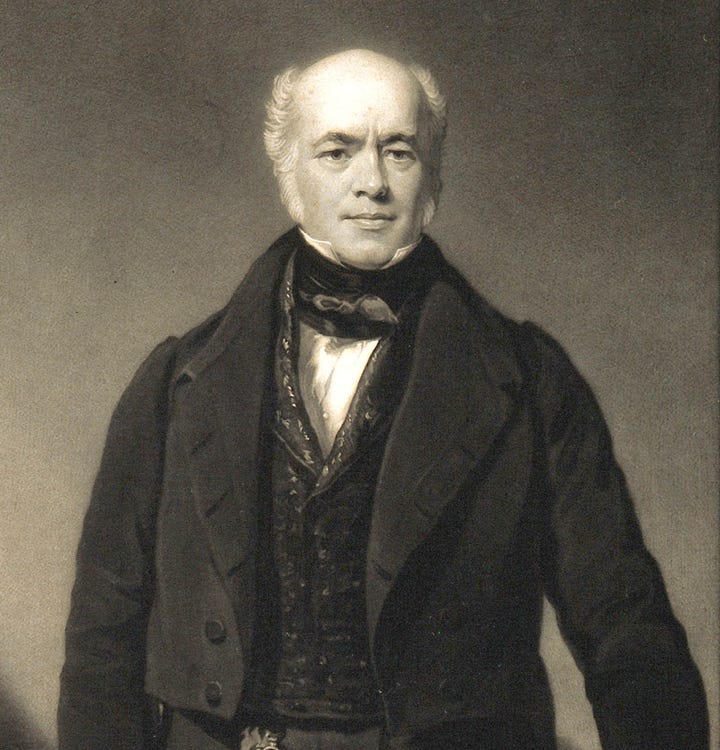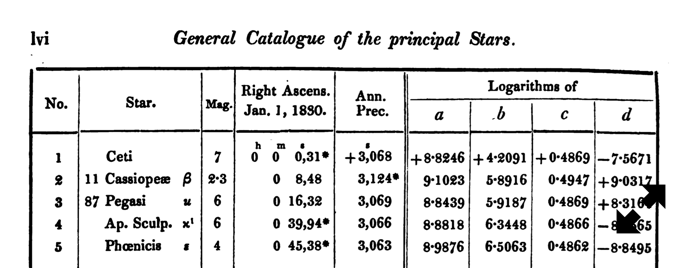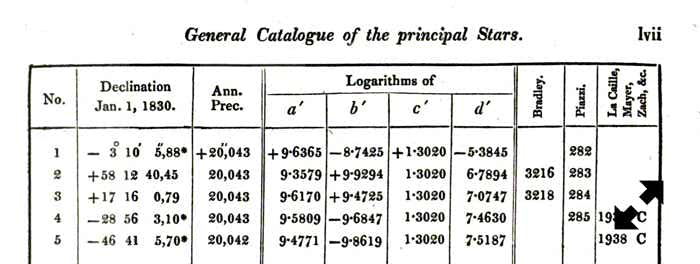Francis Baily and the
British Association Catalogue
Francis Baily (1774–1844), after whom the phenomenon of Baily’s Beads is named, compiled an all-sky catalogue of stars that helped finalize the number and naming of the present-day constellations. This portrait by Thomas Phillips (1770–1845) hangs in the library of the Royal Astronomical Society, of which Baily was a founder. (Wellcome Collection)
ONE of the most influential but under-appreciated star catalogues in astronomical history was The Catalogue of Stars of the British Association for the Advancement of Science, usually known just as the British Association Catalogue or BAC. Published in 1845, it was drawn up by Francis Baily (1774–1844), a former stockbroker and actuary rather than a professional astronomer but whose grasp of positional astronomy was as sound as that of most professionals.
Baily’s British Association Catalogue helped shape the final selection and naming of the 88 constellations that we know today. As the first all-sky compendium of naked-eye stars it was the world’s leading catalogue of its kind for over half a century, until superseded by the Harvard Revised Photometry catalogue of 1908.
Francis Baily and the string of beads
Francis Baily was one of the founders of the Astronomical Society of London (ASL) in 1820, which became the Royal Astronomical Society (RAS) in 1831. He served as secretary of the ASL for its first three years, and was President of the ASL once and the RAS three times. Rich enough from his business activities, he retired in 1825 at the age of 51 to devote the rest of his life to astronomy.
One of his interests was eclipses, for which his name is best-known. Watching an annular eclipse of the Sun on 1836 May 15 from near Jedburgh, southern Scotland, he was surprised to see ‘a row of lucid points, like a string of bright beads’ around the rim of the Moon as it covered the Sun. The phenomenon, caused by mountains on the Moon’s surface breaking up the last remaining arc of sunlight, had been seen before but it had never been so fully described as in Baily’s published report to the RAS. As a result the effect is known as Baily’s beads.
Baily, though, was not primarily an observer. His great strength was as a compiler and analyst of stellar data, utilizing the mathematical talent that he had first employed when calculating life assurance and annuities at the stock exchange. In transferring this skill to astronomy, he exchanged the impermanence of human life for the permanence of the stars. John Herschel described him as ‘a consummate astronomical calculator’, even more remarkably so given that much of his knowledge was seemingly self-taught.
The Astronomical Society of London’s catalogue 1826
Baily’s first star catalogue was produced for the Astronomical Society of London and published by them in 1826. Titled ‘General Catalogue of the principal Stars’ (capitals as in the original), it is usually known as the Astronomical Society of London Catalogue, or just the ASC.
Baily’s aim was to include all stars whose positions were accurately known down to certain magnitude limits. These limits were 5th magnitude and brighter across the whole sky; 6th magnitude and brighter within 30° of the celestial equator; and 7th magnitude and brighter within 10° of the ecliptic. The total number of stars catalogued was 2,881.
Positions and brightnesses were taken from the work of six observers: the English astronomers royal John Flamsteed and James Bradley (in the latter case, as reduced and published by the German F. W. Bessel); the Frenchman Nicolas Louis de Lacaille; the German Tobias Mayer; the Italian Giuseppe Piazzi; and the Hungarian Franz Xaver von Zach.
Entries were tabulated in order of right ascension (rather than constellation-by-constellation as had been the convention from Ptolemy to Flamsteed), and all positions were adjusted to the year 1830. An index of its stars by constellation was later published by Baily’s collaborator, William Samuel Stratford (1791–1853), who was Secretary of the Astronomical Society of London.
Celestial spreadsheets: The first five entries in the Astronomical Society of London’s catalogue (ASC) of 1826. The columns on the left-hand page give the constellation in which the star lies, with any identifying letter or number; the star’s magnitude; its right ascension for 1830; its annual precession; and four constants for calculating changes in its right ascension due to precession, the aberration of light, and nutation of the Earth’s axis. The right hand page gives the star’s declination and precession, with the four computational constants as before. At right are columns containing identifying numbers from the catalogues of Bradley, Piazzi, Lacaille, Tobias Mayer, von Zach, and Hevelius. Click for enlargements.
The ASC was intended as a fundamental catalogue, i.e. a reference from which the positions of other celestial objects could be derived, and was welcomed by practical observers who had previously had to consult a range of separate catalogues of varying reliability and limited availability. John Herschel, the foremost deep-sky observer of the time, called it his ‘sheet anchor’.
But the ASC was just the first step towards an even more comprehensive and accurate successor. Positional astronomy was moving on apace at professional and private observatories in both the northern and southern hemispheres, inspired in part by the ASC, offering the prospects of significant improvements in accuracy and completeness. Baily made his case for a new catalogue in a privately published pamphlet in 1837. At its meeting in Liverpool later that year the British Association for the Advancement of Science agreed to fund its preparation and publication. Baily again took charge, this time with the help of Richard Farley (1810–79) of the Nautical Almanac office who undertook most of the routine calculation.
The British Association Catalogue (BAC) 1845
The Catalogue of Stars of the British Association for the Advancement of Science, to give it its full title, appeared in 1845. It contained entries for 8,377 stars, nearly three times as many as the ASC, with positions calculated for 1850 January 1. Baily chose these stars from what he judged to be the 32 best existing catalogues, as listed in his Preface.
Baily aimed to include all stars down to 6th magnitude, i.e. the naked-eye limit, across the whole sky, and to 7th magnitude within 10° of the ecliptic (the zodiacal band). The layout of the catalogue was much the same as in the ASC, the most significant difference being the addition of a column showing each star’s annual proper motion, where known.
The British Association Catalogue (BAC) of 1845 followed the same format as the earlier Astronomical Society of London’s catalogue, but with additional columns giving the secular (i.e. long-term) change in precession, which is particularly significant for stars near the pole, and the stars’ proper motions. On the right-hand page, declination has been replaced by north polar distance, which avoided the need for + and – signs. Identifying numbers have been added for stars in the catalogues made by Thomas Glanville Taylor at Madras and Thomas Makdougall Brisbane at Parramatta, New South Wales. Click for enlargements.
How well Baily succeeded can be seen by comparing the BAC with the Revised Harvard Photometry, or HR, published by Harvard Observatory in 1908. The Harvard catalogue contained 9,110 stars notionally brighter than magnitude 6.5 and was compiled with the observatory’s own telescopes in Cambridge, Massachusetts, and Arequipa, Peru, from 1879 to 1906, providing a uniform set of observations from pole to pole. Baily’s sources were unavoidably more heterogeneous and incomplete, but even so contained over 90% the number of stars in the HR. In turn, the HR begat the Yale Bright Star Catalogue, which can be seen as the pinnacle of the series of all-sky catalogues of naked-eye stars begun by Baily.
Revising the constellations
As well as its contribution to positional astronomy, the British Association Catalogue helped rationalize the list of accepted constellations and their nomenclature. Francis Baily’s sky, as tabulated in the celestial spreadsheets of the BAC, contained 87 constellations, just one short of the modern total, as follows: all the Ptolemaic figures, with Crux separate from Centaurus as was by then the norm, and Argo split into Carina, Puppis, and Vela, as Nicolas Louis de Lacaille had done; ten figures from Johannes Hevelius and Petrus Plancius, namely Camelopardus (sic), Canes Venatici, Columba, Coma Berenices, Lacerta, Leo Minor, Lynx, Monoceros, Sextans, and Vulpecula; the southern dozen of the Dutch navigators Keyser and de Houtman; and the 14 inventions of Lacaille, although here there was one change – Baily renamed Lacaille’s Pyxis as Malus (the mast of Argo), as John Herschel had suggested, although this change did not catch on.
The only one of the current 88 constellations that was missing was Hevelius’s politically motivated Scutum Sobiescianum, which the English astronomer royal John Flamsteed had also left out of his own catalogue. (It was reinstated by the American astronomer Benjamin Gould, who included it as plain Scutum in his Uranometria Argentina catalogue of 1879.)
Baily adopted John Herschel’s suggestion of shortening Lacaille’s double-barrelled constellation names to a single word. Hence Antlia Pneumatica became plain Antlia, Apparatus Sculptoris became Sculptor, Caelum Scalptorium became Caelum, Equuleus Pictorius became Pictor, Fornax Chimiae became Fornax, Mons Mensae became Mensa, and Piscis Volans became Volans, all names that are still used today. He also shortened Hevelius’s cumbersome Vulpecula cum Ansere to plain Vulpecula.
In addition to this renaming of constellations Baily also assigned Greek letters to stars brighter than magnitude 4.5 in constellations that had not previously had them, namely Camelopardalis, Canes Venatici, Coma Berenices, Lacerta, Leo Minor, Lynx, Monoceros, and Vulpecula – although, in a couple of uncharacteristic oversights, he missed out the letter Alpha in Leo Minor and both Alpha and Beta in Monoceros.
Sadly, Baily did not live to see his masterwork published. He died in 1844 while the British Association Catalogue was still being printed. Fortunately he had completed all the work apart from writing endnotes for around 650 stars. The job was seen through to completion by his long-standing collaborator W. S. Stratford.
© Ian Ridpath. All rights reserved




